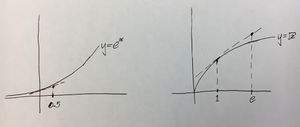Science:Math Exam Resources/Courses/MATH110/April 2018/Question 08 (d)
{{#incat:MER QGQ flag|{{#incat:MER QGH flag|{{#incat:MER QGS flag|}}}}}}
• Q1 (a) • Q1 (b) • Q1 (c) • Q1 (d) • Q1 (e) • Q2 (a) • Q2 (b) • Q2 (c) • Q2 (d) • Q2 (e) • Q3 (a) • Q3 (b) • Q3 (c) • Q4 (a) • Q4 (b) • Q4 (c) • Q4 (d) • Q5 (a) • Q5 (b) • Q5 (c) • Q6 (a) • Q6 (b) • Q7 (a) • Q7 (b) • Q7 (c) • Q7 (d) • Q7 (e) • Q8 (a) • Q8 (b) • Q8 (c) • Q8 (d) • Q9 • Q10 •
Question 08 (d) |
|---|
|
In this question you will approximate the value of in two different ways and answer a few questions about your calculations. Make sure you justify your answers. Answers without justification will not receive any points. You may assume that . (d) Which one of your approximations is an under estimate of ? Explain in words or draw a clear diagram that supports your claim. |
|
Make sure you understand the problem fully: What is the question asking you to do? Are there specific conditions or constraints that you should take note of? How will you know if your answer is correct from your work only? Can you rephrase the question in your own words in a way that makes sense to you? |
|
If you are stuck, check the hint below. Consider it for a while. Does it give you a new idea on how to approach the problem? If so, try it! |
Hint |
|---|
|
This will depend on the convexity/concavity of the functions. |
|
Checking a solution serves two purposes: helping you if, after having used the hint, you still are stuck on the problem; or if you have solved the problem and would like to check your work.
|
{{#incat:MER CT flag||
}}






